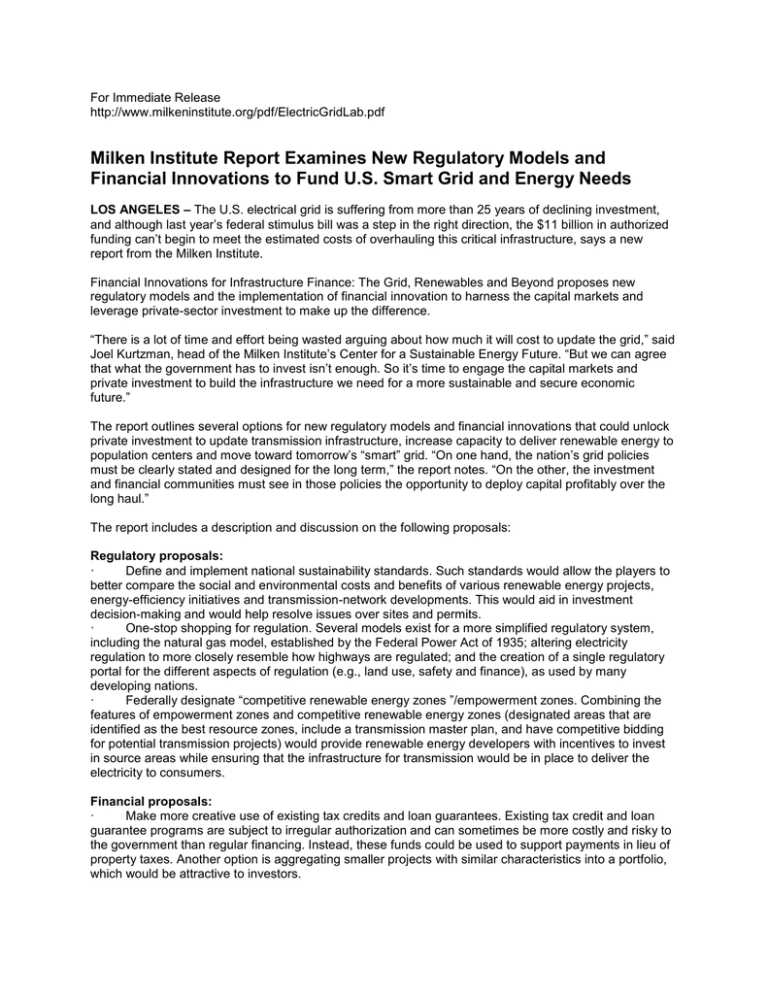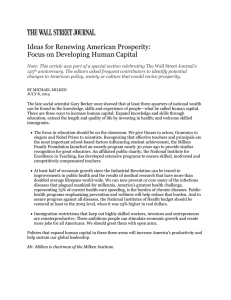Milken Institute Report Examines New Regulatory Models and
advertisement

For Immediate Release http://www.milkeninstitute.org/pdf/ElectricGridLab.pdf Milken Institute Report Examines New Regulatory Models and Financial Innovations to Fund U.S. Smart Grid and Energy Needs LOS ANGELES – The U.S. electrical grid is suffering from more than 25 years of declining investment, and although last year’s federal stimulus bill was a step in the right direction, the $11 billion in authorized funding can’t begin to meet the estimated costs of overhauling this critical infrastructure, says a new report from the Milken Institute. Financial Innovations for Infrastructure Finance: The Grid, Renewables and Beyond proposes new regulatory models and the implementation of financial innovation to harness the capital markets and leverage private-sector investment to make up the difference. “There is a lot of time and effort being wasted arguing about how much it will cost to update the grid,” said Joel Kurtzman, head of the Milken Institute’s Center for a Sustainable Energy Future. “But we can agree that what the government has to invest isn’t enough. So it’s time to engage the capital markets and private investment to build the infrastructure we need for a more sustainable and secure economic future.” The report outlines several options for new regulatory models and financial innovations that could unlock private investment to update transmission infrastructure, increase capacity to deliver renewable energy to population centers and move toward tomorrow’s “smart” grid. “On one hand, the nation’s grid policies must be clearly stated and designed for the long term,” the report notes. “On the other, the investment and financial communities must see in those policies the opportunity to deploy capital profitably over the long haul.” The report includes a description and discussion on the following proposals: Regulatory proposals: · Define and implement national sustainability standards. Such standards would allow the players to better compare the social and environmental costs and benefits of various renewable energy projects, energy-efficiency initiatives and transmission-network developments. This would aid in investment decision-making and would help resolve issues over sites and permits. · One-stop shopping for regulation. Several models exist for a more simplified regulatory system, including the natural gas model, established by the Federal Power Act of 1935; altering electricity regulation to more closely resemble how highways are regulated; and the creation of a single regulatory portal for the different aspects of regulation (e.g., land use, safety and finance), as used by many developing nations. · Federally designate “competitive renewable energy zones ”/empowerment zones. Combining the features of empowerment zones and competitive renewable energy zones (designated areas that are identified as the best resource zones, include a transmission master plan, and have competitive bidding for potential transmission projects) would provide renewable energy developers with incentives to invest in source areas while ensuring that the infrastructure for transmission would be in place to deliver the electricity to consumers. Financial proposals: · Make more creative use of existing tax credits and loan guarantees. Existing tax credit and loan guarantee programs are subject to irregular authorization and can sometimes be more costly and risky to the government than regular financing. Instead, these funds could be used to support payments in lieu of property taxes. Another option is aggregating smaller projects with similar characteristics into a portfolio, which would be attractive to investors. · Allow grid operators to use business models like REITs. A structure similar to a real estate investment trust – which reduces corporate income taxes for a corporation investing in real estate and requires that 90 percent of its income be distributed to its investors – could be used to efficiently finance and sustain electricity infrastructure projects on a tax-advantaged basis. · Establish a revolving fund for green transmission investment projects. Building on the highly successful state revolving funds that address sewage and water-pollution programs, a revolving fund uses government grants and state matches to serve as equity contributions for projects that can be leveraged and then repaid with revenue from usage fees. “The current infrastructure was essentially designed by Thomas Edison in the early part of the last century,” Kurtzman said. “Not only is it ineffective at transmitting power generated from our current system, it’s not capable of transmitting intermittent power from alternative sources such as wind and solar. The current grid is a barrier to job creation and will be a stumbling block for the 21st century energy economy.” The report is the result of a Financial Innovations LabTM hosted by the Milken Institute with support from the U.S. Department of Agriculture. The lab was held in Washington, D.C., and included economists, authorities on energy policy, utility operators (privately owned and cooperatives), investors, real estate developers, regulators, representatives from technology and infrastructure companies, researchers and scholars. Financial Innovations Labs are part of the Milken Institute’s continuing leadership in promoting financial innovations to help solve ongoing social, economic and environmental challenges. The full report is available at www.milkeninstitute.org. Contact: Jennifer Manfrè, Associate Director of Communications (310) 570-4623, jmanfre@milkeninstitute.org About the Institute: The Milken Institute is a nonprofit, independent economic think tank whose mission is to improve the lives and economic conditions of diverse populations around the world by helping business and public policy leaders identify and implement innovative ideas for creating broad-based prosperity. It is based in Santa Monica, CA. (www.milkeninstitute.org)###


